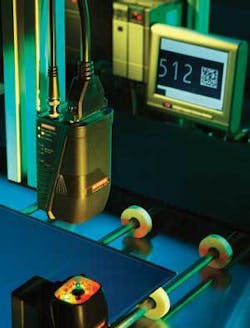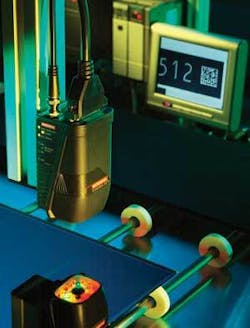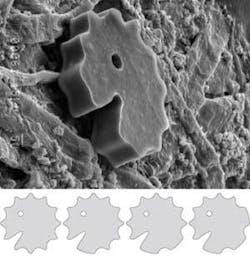Barcodes find new delivery mechanisms
New technologies and applications will fuel the growth of barcode-identification systems.
By Andrew Wilson, Editor
In 1952, Bernard Silver and Norman Woodland of Drexel University patented a method for identifying products using graphical symbols. The idea, which was the origin of barcode technology, was not commercialized until 1967, when RCA developed and installed a proprietary scanning system based on a “bulls-eye” barcode at a Kroger department store in Cincinnati, OH, USA. After limited success, the National Association of Food Chains recognized that a universal coding scheme would be needed for the idea to proliferate. This resulted in the Universal Grocery Products Identification Code in 1970 and later the now-ubiquitous UPC symbol used worldwide.
Today, numerous barcodes exist for a variety of applications (see Table 1). Which one is suitable for any given application depends on its implementation, the data that are required to be encoded, and how the barcode is to be marked or printed. Each different type or symbology defines how a specific symbol is printed and how it is decoded by an imaging or machine-vision system.
(Click here to download a PDF of the tables)
In industrial parts-marking applications, one of the most successful symbologies has been the 2-D Data Matrix code, originally developed by RVSI Acuity Matrix, now Siemens Energy and Automation, Automation and Motion Division. Placed in the public domain, this is the standard specified by the Electronic Industries Association, Semiconductor Equipment and Materials International (SEMI), Automotive Industry Action Group, Society of Automotive Engineers, NASA, the Air Transport Association, and the US Department of Defense for meeting a variety of item-traceability and lifetime identification requirements.
“To read Data Matrix symbols, some type of imager must be used,” says Bill Munroe, director of marketing at Microscan. “Laser scanners cannot be used because they are generally not effective reading in two dimensions,” he says. Laser scanners also typically require more contrast than many Data Matrix symbols provide. Acceptable imager options range from simple CCD-based readers to fully integrated CMOS-based smart cameras and even to high-end vision systems using separate lighting, lensing, and image processors (see Fig. 1).
“For a barcode symbology to be used effectively, it must be based on a clear and open standard,” says Munroe. “Such standards provide structure and ensure that users and barcode-technology providers have uniform performance. A series of ISO standards (ISO/IEC 16022, 15418, 15434, and 15415) have established the technical specifications for Data Matrix symbols, encoding, formatting, and quality. Various industry standards continue to be built using ISO standards as the technical foundation for adding further specifications for symbol size, data content, and usage requirements” (see Table 2).
Graphical symbols
While the graphical symbols used in the Data Matrix code offer numerous benefits over conventional barcodes, such as high information density, scalability, and built-in error correction, they will not remain the sole method of marking products. Interestingly, the original patent assigned to Silver and Woodland does not specify an individual marking scheme but rather the generalized use of graphical symbols. Neither does the patent suggest a specific delivery mechanism for coding specific products with a barcode.
Because of this, a number of companies are currently developing both novel symbologies and delivery mechanisms for the next generation of product-coding systems. While such developments remain specialized, they do offer many opportunities for developers of barcode-recognition systems.
In many applications, open standards such as the Data Matrix code are useful since, as the standard is in the public domain, equipment from numerous vendors can be used to mark and read the code. In other applications, where, for example, data must be protected from illegal reading, proprietary codes may be required. Because in some circumstances counterfeit or unapproved parts and components create risks that impact safety, warranties, and liability, Orbid has developed a proprietary coding system known as Two-Dimensional Mark Identification (2DMI). Orbid’s 2DMI coding system provides products with a unique printed mark that enables secure track and trace of marked products (Fig. 2).
To mark a device with the Orbid code, proprietary software encrypts a serial number, production date, and customer ID into a 2DMI code. The 2DMI code is then applied to a product, either by printing it on a label or by direct part marking. According to Orbid, data capacity ranges from seven to more than 30 decimals, and the code can be produced in sizes ranging from 0.1 mm with less than 10% contrast required to read the part.
Product markers
While 2-D symbologies such as Data Matrix and 2DMI codes provide the means of encoding data for both commercial and secure applications, they are only useful to mark parts or products directly. They cannot be used in applications such as drug or food traceability, where markers may need to be embedded within the product. Realizing this, Burntside Partners has developed a product-authentication system based on microscopic product markers, or “taggants,” that can carry the amount of information currently stored in a barcode on an edible wafer smaller than a cross section of a human hair.
“For food and drug applications,” says Stephen Nightingale, president and CEO of Burntside Partners, “the marker carrying this number must be edible.” One such marker substance is polylactic acid, which is made by condensation from corn fructose and hydrolyzes, at controllable rates, back to fructose (see Fig. 3 on p. 39). “However, because these markers can be made from any substance that can be extruded or drawn into a fiber, they can be made from more-durable materials, such as high-density polyethylene, and can preserve the identity of tiny machine, aviation, and computer parts where conventional 1-D and 2-D barcoding technologies are impractical.”
Each 50-µm-diameter marker is about 10 µm thick and shaped like a human face with a deep orienting groove representing a mouth, a small orienting void representing an eye, and 11 shallow identifying grooves around its perimeter. Each of these peripheral identifying grooves can be present or absent. As the design of the orienting groove and void is asymmetric, an observer can distinguish the top, or “heads,” face of the marker from the bottom, or “tails,” face and can distinguish the order and number of identifying grooves around the perimeter of the marker. And, because of the asymmetric design, the amount of information that can be stored in them increases exponentially rather than linearly as the number of identifying grooves is increased.
Delivery mechanisms
Other manufacturers are looking at developing new delivery mechanisms with which to deploy codes. To do this, vendors are discovering that they must leverage multiple scientific disciplines to engineer their products. Combining chemistry, substrate conversion, and laser technology, Packmark technology, developed by DataLase, uses a coding and marking method to apply coded information to products and packaging materials. The process uses an inert inorganic additive that undergoes a color-change reaction to form a positive contrast image or code once exposed to a low-level carbon dioxide (CO2) marking laser.
The material to be marked can be treated either by direct doping of Packmark into the substrate or its existing surface coating, or by a separate coating or printing operation. The subsequent laser imaging process does not require any ink or ribbons and can be used for any type of primary packaging substrate, including flexible packaging, paper, board, and plastics. At present, the company offers the technology to write a number of different codes on products that address numerous applications, including label packaging replacement, on-product marking of foodstuffs, and on-tablet marking (see Fig. 4 on p. 40). These codes can be read by a number of currently available barcode-recognition systems.
Already, bag-closure-manufacturer Kwik Lok Australia has adopted the DataLase technology to date-code bread-bag closures for George Weston Foods, one of Australia’s largest food manufacturers, having more than 75% of Australian households buying its bread. The bread is sealed using Kwik Lok all-plastic bag closures, which are marked to provide information on cost, freshness, and other package information.
Kwik Lok applies DataLase inorganic additive directly to the bread-bag-closure polymer by extrusion. The additive is nontoxic and can produce an image when marked by a 10-W CO2 laser. Once exposed, the additive undergoes a color change to create a date code. According to DataLase, this has resulted in faster production run times for the company and removed the need for expensive consumables on the production line.
In your genes
While current coding methods and delivery systems can place markers on and within numerous substances, Derek Matthews, a molecular biologist at the UK National Institute of Agricultural Botany, has patented a method to store encoded information within biological macromolecules. The idea, which can be read on the Web at www.niab.com/filearea/barcode14023.pdf, shows how coded information can be encoded into biological macromolecules such as DNA, RNA, and PNA in a structured way with the intention of recovering that information at a later date.
“The use of codes embedded in DNA, RNA, and PNA has a range of potential uses,” says Matthews. “Potential applications can be divided into two categories--those where DNA is incorporated into an organism by genetic modification and those where coded DNA or PNA is used as a security marker. Where coded DNA is inserted into an organism by genetic modification, it could protect intellectual property. Using DNA or PNA as a security marker would involve applying a solution of DNA fragments containing coded information to surfaces. The DNA could later be recovered, copied, and sequenced to reveal the code.”
Developing imaging or bioimaging systems to reveal these sequences will present a further challenge for developers. And such radical developments may not find favor among those who believe that the technology could be used for alternative purposes, such as marking individual human beings. Just as Silver and Woodland never profited greatly from their original patent, it may be a number of years before the next generation of marking technologies is fully developed, standardized, and deployed.
Company Info
Burntside Partners
Bethesda, MD, USA
www.burntsidepartners.com
DataLase
Widnes, UK
www.datalase.com
Drexel University
Philadelphia, PA, USA
www.drexel.edu
George Weston Foods
Chatswood, Australia
www.georgewestonfoods.com.au
Kwik Lok Australia
Cheltenham, Australia
kwiklok.com
Microscan
Renton, WA, USA
www.microscan.com
National Institute of Agricultural Botany
Cambridge, UK
www.niab.com
Orbid
San Francisco, CA, USA
www.orbidcorp.com
Siemens Energy and Automation, Automation & Motion Division-Vision Center of Competence
Nashua, NH, USA
www.usa.siemens.com




